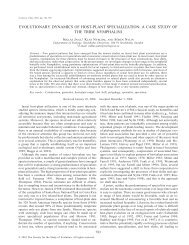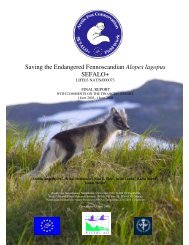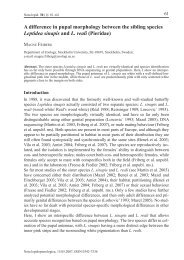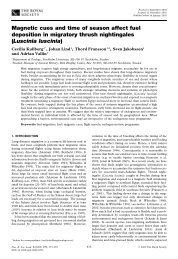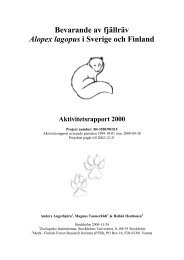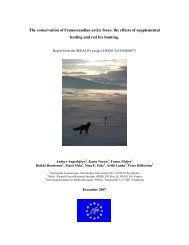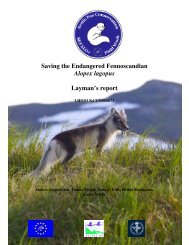Food-niche overlap between arctic and red foxes
Food-niche overlap between arctic and red foxes
Food-niche overlap between arctic and red foxes
Create successful ePaper yourself
Turn your PDF publications into a flip-book with our unique Google optimized e-Paper software.
Elmhagen et al. 1275al. 1999). To assess the importance of competition <strong>between</strong><strong>arctic</strong> <strong>and</strong> <strong>red</strong> <strong>foxes</strong>, it is therefore necessary to study their<strong>niche</strong> <strong>overlap</strong>, <strong>and</strong> food <strong>niche</strong> is one dimension.Arctic <strong>foxes</strong> in Fennosc<strong>and</strong>ia <strong>and</strong> other inl<strong>and</strong> habitatstypically use lemmings as their primary prey, but they alsoinclude voles, birds, eggs, hares, insects, berries, <strong>and</strong> carcassesof reindeer or caribou (Rangifer tar<strong>and</strong>us) in theirdiet (Macpherson 1969; Angerbjörn et al. 1999; Str<strong>and</strong> et al.1999; Dalerum <strong>and</strong> Angerbjörn 2000; Elmhagen et al. 2000).Voles are usually the most important prey for <strong>red</strong> <strong>foxes</strong>in Sweden <strong>and</strong> northern Europe, but birds, eggs, roe deer(Capreolus capreolus), lagomorphs, insects, fruit, <strong>and</strong> berriesare also fed upon (Englund 1965; Lindström 1989; Goszczynski1974; Leckie et al. 1998; O’Mahony et al. 1999). In a review,Hersteinsson <strong>and</strong> Macdonald (1982) concluded thatboth <strong>arctic</strong> <strong>and</strong> <strong>red</strong> <strong>foxes</strong> are highly opportunistic, <strong>and</strong> suggestedthat the more limited prey base in <strong>arctic</strong> areas is theonly reason why <strong>arctic</strong> fox populations often have a less varieddiet than <strong>red</strong> fox populations. This assumption is supportedby the results of a feeding experiment in which <strong>foxes</strong>could choose <strong>between</strong> already dead prey of different species:neither <strong>red</strong> <strong>foxes</strong> nor <strong>arctic</strong> <strong>foxes</strong> showed a preference forvoles or lemmings (Barth et al. 2000). On the contrary, threedietary studies involving sympatric <strong>arctic</strong> <strong>and</strong> <strong>red</strong> <strong>foxes</strong> showedthat <strong>arctic</strong> <strong>foxes</strong> generally eat more lemmings <strong>and</strong> fewervoles than <strong>red</strong> <strong>foxes</strong> do, <strong>and</strong> it was suggested that <strong>red</strong> <strong>foxes</strong>could be more generalistic feeders (Smits et al. 1989; Frafjord1995; Frafjord 2000). However, the samples in the two earlierstudies were very small <strong>and</strong> none of the studies providedany data on prey availability. Thus, it is not possible to determinewith certainty what causes the observed dietary differences.Either <strong>arctic</strong> <strong>and</strong> <strong>red</strong> <strong>foxes</strong> could have differenthunting behaviours that result in different prey preferences,or they could be segregated on a small spatial scale <strong>and</strong>therefore have access to different prey bases in areas wherethey are regarded as sympatric. Differences in prey preferencesindicate that there is food-<strong>niche</strong> separation <strong>between</strong>the fox species <strong>and</strong> that competition may be of less importance.However, if there are no fundamental food-<strong>niche</strong> differences,spatial segregation could result from interspecificcompetition.The best way to determine if two species compete is tocompare “actual” <strong>and</strong> “virtual” <strong>niche</strong> <strong>overlap</strong>s, these beingthe local population equivalents of the realised <strong>and</strong> fundamental<strong>niche</strong>s of an entire species (Colwell <strong>and</strong> Futuyma1970). For example, food competition <strong>between</strong> mink (Mustelavision) <strong>and</strong> otter (Lutra lutra) was investigated throughcomparisons of food-<strong>niche</strong> breadths <strong>and</strong> food-<strong>niche</strong> <strong>overlap</strong>sunder sympatric <strong>and</strong> allopatric conditions (Clode <strong>and</strong> Macdonald1995). In Fennosc<strong>and</strong>ia there are no areas of mountaintundra where <strong>red</strong> <strong>foxes</strong> are absent to the extent that wecould study the “virtual diet” of the <strong>arctic</strong> fox. However, wecan test whether there is small-scale spatial segregation <strong>between</strong>the species with respect to altitude, an important habitatvariable. Further, lemming <strong>and</strong> vole populations fluctuateover time <strong>and</strong> relative abundances change from year to yearat all altitudes (Oksanen et al. 1999). Thus, we can alsostudy how <strong>arctic</strong> <strong>and</strong> <strong>red</strong> <strong>foxes</strong> respond to differences in preyspecies composition. If there are species-specific differencesin prey preferences, i.e., if <strong>arctic</strong> <strong>and</strong> <strong>red</strong> <strong>foxes</strong> have differenthunting behaviours, they will respond differently to changesin the composition of the prey community. Consequently,the degree of <strong>niche</strong> <strong>overlap</strong> will vary <strong>between</strong> years. If, instead,they use prey similarly, <strong>niche</strong> <strong>overlap</strong>s should be relativelyconstant in time. There are four possible scenariosdepending on the existence of spatial segregation <strong>and</strong> (or)species-specific prey use: (1) No spatial segregation, no differencesin prey preferences: <strong>arctic</strong> <strong>and</strong> <strong>red</strong> <strong>foxes</strong> have thesame diets, i.e., food-<strong>niche</strong> <strong>overlap</strong> is 100%. (2) No spatialsegregation, different prey preferences: <strong>arctic</strong> <strong>and</strong> <strong>red</strong> <strong>foxes</strong>have different diets <strong>and</strong> the degree of food-<strong>niche</strong> <strong>overlap</strong>changes <strong>between</strong> years. (3) Spatial segregation, no differencesin prey preferences: <strong>arctic</strong> <strong>and</strong> <strong>red</strong> <strong>foxes</strong> have differentdiets, owing to differences in the composition of the preycommunity at different altitudes, but the degree of food<strong>niche</strong><strong>overlap</strong> is consistent <strong>between</strong> years. (4) Spatial segregation,different prey preferences: <strong>arctic</strong> <strong>and</strong> <strong>red</strong> <strong>foxes</strong> havedifferent diets <strong>and</strong> the degree of food-<strong>niche</strong> <strong>overlap</strong> changes<strong>between</strong> years.In this study we investigated the summer diets of sympatric<strong>arctic</strong> <strong>and</strong> <strong>red</strong> <strong>foxes</strong> over 4 years to find out which scenariois enacted on the Fennosc<strong>and</strong>ian mountain tundra. We testfor dietary differences <strong>between</strong> <strong>arctic</strong> <strong>and</strong> <strong>red</strong> <strong>foxes</strong>, foraltitudinal segregation <strong>between</strong> these species, <strong>and</strong> for an effectof altitude on the occurrence of different prey species intheir diets. We also study whether food-<strong>niche</strong> <strong>overlap</strong> <strong>and</strong>food-<strong>niche</strong> breadth change <strong>between</strong> years. Finally, we discussthe implications of <strong>arctic</strong> <strong>and</strong> <strong>red</strong> fox food <strong>niche</strong>s forthe degree of interspecific competition.Materials <strong>and</strong> methodsStudy areaThe study area cove<strong>red</strong> 1300 km 2 of mountain tundra inthe Vindelfjällen Nature Reserve in Swedish Lapl<strong>and</strong> (66°N,16°E). The main vegetation types were dry heath, grass heath,<strong>and</strong> dry fen. Plant-species diversity was low, except for somerelatively rich patches (Rune 1981). Arctic <strong>foxes</strong> b<strong>red</strong> onlyabove the tree line, which was situated at 750 m asl. Most<strong>red</strong> <strong>foxes</strong> breed below the tree line, in birch <strong>and</strong> coniferousforests, but all <strong>red</strong> <strong>foxes</strong> included in this study inhabited former<strong>arctic</strong> fox dens on the mountain tundra. These dens arehereinafter refer<strong>red</strong> to as <strong>red</strong> fox dens. Prey species availableto the <strong>foxes</strong> were Norwegian lemming (Lemmus lemmus), fieldvole (Microtus agrestis), bank vole (Clethrionomys glareolus),grey-sided vole (Clethrionomys rufocanus), shrews (Sorex spp.),mountain hare (Lepus timidus), reindeer, rock ptarmigan(Lagopus mutus), willow ptarmigan (Lagopus lagopus), passerines(Passeriformes), ducks (Anseriformes), gulls, <strong>and</strong> waders(Charadriiformes).Lemming <strong>and</strong> vole populations are generally cyclic in <strong>arctic</strong><strong>and</strong> mountain tundra areas (Elton 1924; Hanski et al.1991; Angerbjörn et al. 2001), but there have been occasionalprolonged interruptions in the cycle in Fennosc<strong>and</strong>ia(Angerbjörn et al. 2001). During these, lemming populationsfluctuate with a periodicity resembling the normal cycle, butthe amplitude is smaller than usual. The interruptions havetherefore been described as periods without peak years, sincethe highest lemming densities are about 10 times lower th<strong>and</strong>uring “real” peaks (Angerbjörn et al. 2001; Tannerfeldt etal. 2002). The last lemming peak in Sweden occur<strong>red</strong> in1982, consequently our study was carried out during one of© 2002 NRC Canada



